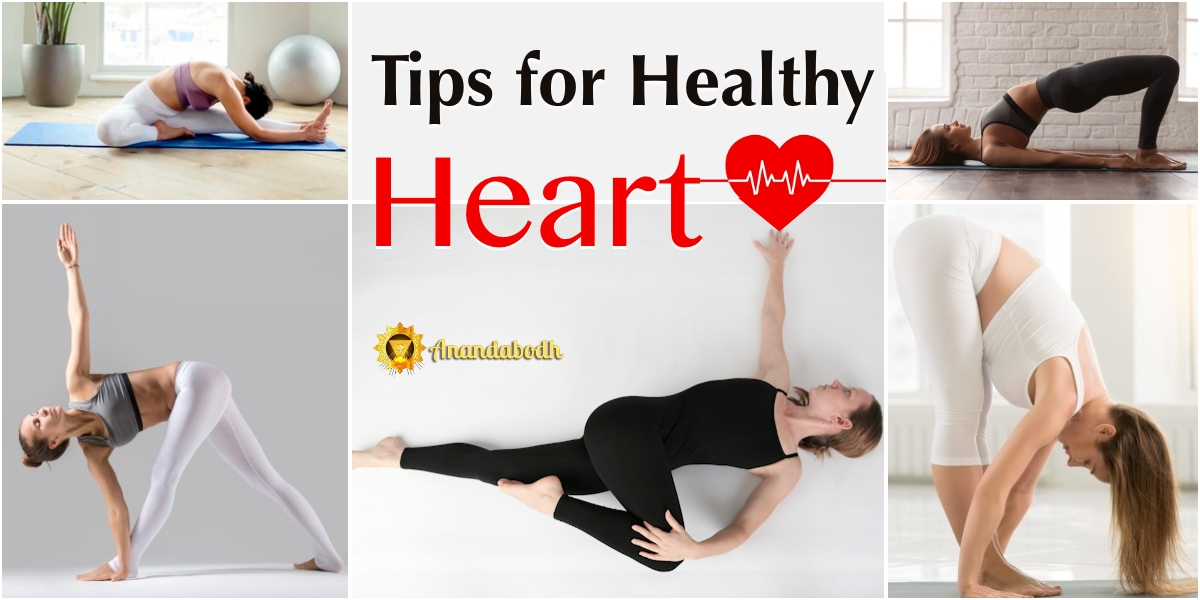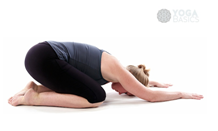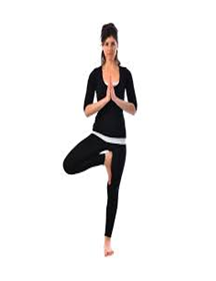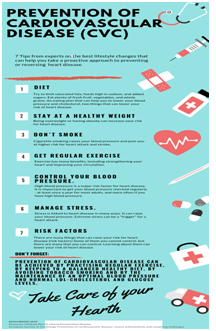The heart is one of the most important organs in the human body. The heart pumps the blood, which carries all the vital materials which help our bodies function and removes the waste products that we do not need
For example, the brain requires oxygen and glucose, which, if not received continuously, will cause it to lose consciousness. Muscles need oxygen, glucose and amino acids, the proper ratio of sodium, calcium and potassium salts to contract normally. Glands need sufficient supplies of raw materials from which to manufacture specific secretions. If the heart ever ceases to pump blood, the body begins to shut down and after a very short period of time will die.
Exercise that gets your heart rate pumping isn’t the only way to help improve your cardiovascular health. Managing stress also is critical to your overall heart health. Yoga’s clearest benefit to heart health is its ability to relax the body and mind. The practice of yoga also can increase strength, flexibility, and overall stamina, making it a great fit for a healthy lifestyle.
Yoga has been associated with improvements in numerous cardiovascular risk factors and has the potential to address the unmet needs of current cardiovascular prevention strategies.
Many forms of heart disease can be prevented or treated with healthy lifestyle choices. Yoga practice is the best way to keep the heart healthy. Asana prepares the entire physical functioning of the body, while pranayama improves the physiology of the body.
Standing poses strengthen the cardiac reserve. Forward bends soothes the nerves and brings down the heart rate. Inverted pose improves the contractility. Back bending poses lengthen the cardiac muscle and the septum. This improves the contraction of heart and improves the quality to pump blood in and out. Twisting pose stretches the wall of the heart. The diaphragm is squeezed and the endurance of the heart is increased.
Pranayama, on the other hand, constantly changes the shape of the heart, thereby preventing blockage in the heart. Prana is the vital energy distributed by the nervous channel (Nadis). Pranayama improves the rhythm of the heart. One who practice pranayama consistently can reduce or increase the heart rate at will. Hence, one gains control over the involuntary mechanism of the body.
Yoga can be done by any one at any age at any health problems. The body system is taken care of, with all the internal organs functioning together to improve the cardiovascular efficiency. Any practitioner can benefit from the practice – whether as preventive, improvement or reverting to normal condition.
As with any form of therapy, yoga can result in adverse events especially when practiced without adequate guidance, instruction, and when extreme forms are practiced. The most important part of yoga practice is choosing the right form and tailoring it to individual needs and limitations.
For example, Hatha yoga, if not performed in certain sequences, may lead to gastric discomfort, nausea, and vomiting. Musculoskeletal side effects are also possible if physically intense yoga methods are followed without proper supervision. Kundalini syndrome, characterized by headaches, motor and sensory effects, high BP, increased HR, insomnia and psycho-social issues, may result from performing Kundalini yoga incorrectly or too often. Rare adverse events have also been reported with extremes of temperature used in certain types of yoga. Despite these limitations, most studies assessing the safety of yoga have demonstrated very low rates of adverse events.
Here are some yoga poses for a healthy heart:
1. HAND TO FOOT POSE
In this pose, you engage a deep stretch by bending forward from a standing position with your legs straight and feet together or hip-width apart. Bring your head toward your knees and place your palms or fingertips on the floor in line with your feet. This pose stretches the spine, hamstrings, shoulders, and groin. It can relieve pain and increase flexibility.
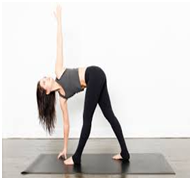
2. EXTENDED TRIANGLE POSE
From a standing position, step your right foot 3-4 feet from your left foot. Turn your left foot about 45 degrees to the right. Place your right foot at 90 degrees. Shift your left hip back toward your left heel and lean your torso to the right. Reach your left hand down, either to the floor (or a block) outside of your right foot or against your right shin. As you turn and look up, raise your right arm to the sky, with fingers pointing upwards. Inhale and exhale for three counts, while keeping your legs straight and thighs firm. Repeat on the opposite side. This pose stretches and strengthens the chest, torso, and legs to promote increased stamina.
3. BRIDGE POSE
Lying on your back with your knees bent and feet on the floor, place your feet about hip-width apart and bring your knees over your ankles. As you press your feet into the floor, lift your bottom off the floor and hold it in the air while lifting your hips toward the ceiling. You can rest your arms on the floor at your side, or you can roll your shoulders under your body and clasp your hands below your pelvis on the floor. This pose will help stretch the spine and chest and relieve stress. It also can be therapeutic for someone with high blood pressure.
4. CHAIR POSE
From a standing position with your feet together or slightly apart and toes facing forward, raise your arms overhead and bend your knees. With your thighs touching (or slightly apart), bring your thighs nearly parallel to the floor. Your knees will protrude forward, and your torso will slightly lean forward over the thighs. Hold this position for up to a minute before returning to the starting position and repeating. This pose engages the leg and arm muscles, while stimulating the diaphragm and heart.
5. HEAD TO KNEE POSE
Sit on the floor with your legs straight in front of you. Bend your right leg so the bottom of your right foot rests on the inner thigh of your left leg. Reach both arms toward your left foot, keeping your left leg straight on the ground, and come into a forward bend. Lower your forehead toward your straight leg as you breathe into the stretch. Repeat on the opposite side. This pose will help stretch the spine, shoulders, hamstrings, and groin. It may also help relieve anxiety and fatigue.
6. EASY POSE
Begin in a seated, upright position with your feet crossed underneath the opposite thigh. Place your hands in your lap, with your palms facing up or on your knees, and breathe in this pose for several minutes. This pose can help relax the body and mind while strengthening the back. You can use your time as a mini-meditation.
7. SUPINE SPINAL TWIST
Lie on your back and bring your right knee to your chest, then across your left side. Extend your right arm out to the side and take several deep breaths. Repeat on your left side. Another variation focuses on raising both knees across each side. This gentle twist helps to relieve tension in the spine and relax the body.
8. SHASHANKASANA OR CHILD’S POSE
Begin by kneeling on the floor and sitting on your feet. Separate your knees as wide as your hips and bring your big toes together. Lay your torso forward between your thighs, extending your arms in front of you on the floor. Lay your forehead against the floor and rest in this position for a few minutes. This pose stretches the hips and thighs while relaxing the mind and reducing stress. It can also help relieve back pain.
9. LEGS UP THE WALL
This pose is exactly as it sounds. Lie on your back on the floor and position both legs against the wall. Lie this way for several minutes. The blood flows to the heart, providing a soothing, relaxing experience. It is especially helpful for better sleep.
10. SHAVASANA OR CORPSE POSE
Lie on your back with your arms and legs relaxed. Reach your arms out to the sides with your palms facing up. Close your eyes and take a few minutes to focus your attention on your body and your breathing. This can help relieve stress.
11. REVIEW THE DAY:
Sit in any meditative posture and close the eyes. If not possible to sit on the floor, sit on a firm chair with an erect backrest. Mentally, passively review the events of previous day in detail and in chronological order. Do not judge or analyse any thought/event. When we go deeper into the technique beyond mere chronological listing of events; we have to analyse our state of mind, our feelings and even thoughts while living that particular moment. Practice daily, preferably before bedtime. Take some time off your daily schedule for moments of quiet and silence.
1. ONE LEGGED PRAYER POSE
This practice not only enables co-ordination and balance but also promotes mental poise and spiritual elevation. Stand erect with hands at their respective sides and feet as close together as possible. Keep the knees straight but not stiff. Place the body weight on the balls of the feet, towards the big toe. Keep the neck straight and abdomen in normal contour and chin drawn in. The pelvis tilted at a subtle angle as to prevent any exaggeration of the lumbar curve. Focus your eyes at any one point straight ahead, keeping the mind calm and body relaxed. Fold both the hands in Namaskar mudra and place them in front of the chest. Keep the shoulders and elbows relaxed. Close the eyes (or fix the gaze at any one point) and passively observe the breath (final position). Mind may wander to other thoughts but gently bring it back to breath. Initially stay in the position for a few minutes, taking it up to 10 minutes with regular practice.
Limitations / Contraindications: People suffering from acute arthritis (lower limbs) and varicose veins should not stand for a long time. In case of vertigo, keep the eyes open and gaze.
12. THE FIRM POSTURE
Lie down on your back taking support of your hand and turn to your left side. Align your body in straight line and keep your legs one on top of the other. Rest the right arm on to your body. Eyes closed and relax in this posture for 5 minutes.
13. ANULOM VILOM PRANAYAMA and NADI SHODHANA PRANAYAMA
Beat diabetes, heart disease and high cholesterol with this Pranayama.
Strategies to prevent heart disease
Heart disease is a leading cause of death, but it’s not inevitable. While you can’t change some risk factors — such as family history, sex or age — there are plenty of ways you can reduce your risk of heart disease.
Get started with these seven tips for boosting your heart health:
1. Don’t smoke or use tobacco
One of the best things you can do for your heart is to stop smoking or using smokeless tobacco. Even if you’re not a smoker, be sure to avoid secondhand smoke.
Chemicals in tobacco can damage your heart and blood vessels. Cigarette smoke reduces the oxygen in your blood, which increases your blood pressure and heart rate because your heart has to work harder to supply enough oxygen to your body and brain.
There’s good news though. Your risk of heart disease starts to drop in as little as a day after quitting. After a year without cigarettes, your risk of heart disease drops to about half that of a smoker. No matter how long or how much you smoked, you’ll start reaping rewards as soon as you quit.
2. Get moving: Aim for at least 30 to 60 minutes of activity daily
Regular, daily physical activity can lower your risk of heart disease. Physical activity helps you control your weight and reduce your chances of developing other conditions that may put a strain on your heart, such as high blood pressure, high cholesterol and type 2 diabetes.
If you haven’t been active for a while, you may need to slowly work your way up to these goals, but in general, you should aim for at least:
- 150 minutes a week of moderate aerobic exercise, such as walking at a brisk pace
- 75 minutes a week of vigorous aerobic activity, such as running
- Two or more strength training sessions a week
Even shorter bouts of activity offer heart benefits, so if you can’t meet those guidelines, don’t give up. Just five minutes of moving can help, and activities such as gardening, housekeeping, taking the stairs and walking the dog all count toward your total. You don’t have to exercise strenuously to achieve benefits, but you can see bigger benefits by increasing the intensity, duration and frequency of your workouts.
3. Eat a heart-healthy diet
A healthy diet can help protect your heart, improve your blood pressure and cholesterol, and reduce your risk of type 2 diabetes. A heart-healthy eating plan includes:
- Vegetables and fruits
- Beans or other legumes
- Lean meats and fish
- Low-fat or fat-free dairy foods
- Whole grains
- Healthy fats, such as olive oil
Limit intake of the following:
- Salt
- Sugar
- Processed carbohydrates
- Alcohol
- Saturated fat (found in red meat and full-fat dairy products) and trans fat (found in fried fast food, chips, baked goods)
4. Maintain a healthy weight
Being overweight — especially around your middle — increases your risk of heart disease. Excess weight can lead to conditions that increase your chances of developing heart disease — including high blood pressure, high cholesterol and type 2 diabetes.
One way to see if your weight is healthy is to calculate your body mass index (BMI), which uses your height and weight to determine whether you have a healthy or unhealthy percentage of body fat. A BMI of 25 or higher is considered overweight and is generally associated with higher cholesterol, higher blood pressure, and an increased risk of heart disease and stroke.
Waist circumference also can be a useful tool to measure how much abdominal fat you have. Your risk of heart disease is higher if your waist measurement is greater than:
- 40 inches (101.6 centimeters, or cm) for men
- 35 inches (88.9 cm) for women
Even a small weight loss can be beneficial. Reducing your weight by just 3% to 5% can help decrease certain fats in your blood (triglycerides), lower your blood sugar (glucose) and reduce your risk of type 2 diabetes. Losing even more helps lower your blood pressure and blood cholesterol level.
5. Get good quality sleep
A lack of sleep can do more than leave you yawning; it can harm your health. People who don’t get enough sleep have a higher risk of obesity, high blood pressure, heart attack, diabetes and depression.
Most adults need at least seven hours of sleep each night. Make sleep a priority in your life. Set a sleep schedule and stick to it by going to bed and waking up at the same times each day. Keep your bedroom dark and quiet, so it’s easier to sleep.
If you feel like you’ve been getting enough sleep but you’re still tired throughout the day, ask your doctor if you need to be evaluated for obstructive sleep apnea, a condition that can increase your risk of heart disease. Signs of obstructive sleep apnea include loud snoring, stopping breathing for short times during sleep and waking up gasping for air. Treatments for obstructive sleep apnea may include losing weight if you’re overweight or using a continuous positive airway pressure (CPAP) device that keeps your airway open while you sleep.
6. Manage stress
Some people cope with stress in unhealthy ways — such as overeating, drinking or smoking. Finding alternative ways to manage stress — such as physical activity, relaxation exercises or meditation — can help improve your health.

7. Get regular health screenings
High blood pressure and high cholesterol can damage your heart and blood vessels. But without testing for them, you probably won’t know whether you have these conditions. Regular screening can tell you what your numbers are and whether you need to take action.
- Blood pressure. Regular blood pressure screenings usually start in childhood. Starting at age 18, your blood pressure should be measured at least once every two years to screen for high blood pressure as a risk factor for heart disease and stroke.
If you’re between 18 and 39 and have risk factors for high blood pressure, you’ll likely be screened once a year. People age 40 and older also are given a blood pressure test annually.
- Cholesterol levels. Adults generally have their cholesterol measured at least once every four to six years. Cholesterol screening usually starts at age 20, though earlier testing may be recommended if you have other risk factors, such as a family history of early-onset heart disease.
- Type 2 diabetes screening. Diabetes is a risk factor for heart disease. If you have risk factors for diabetes, such as being overweight or having a family history of diabetes, your doctor may recommend early screening. If your weight is normal and you don’t have other risk factors for type 2 diabetes, screening is recommended beginning at age 45, with retesting every three years.
If you have a condition such as high cholesterol, high blood pressure or diabetes, your doctor may prescribe medications and recommend lifestyle changes. Make sure to take your medications as your doctor prescribes and follow a healthy-lifestyle plan.
A daily Yoga practice leads to a healthy lifestyle. It changes the overall character of a practitioner, controls high blood pressure and diabetes. The effect is more significant with a proper diet. Pranayama gives proper relaxation to reduce and manage stress. A conscious breathing rhythm regulates the heartbeat.





